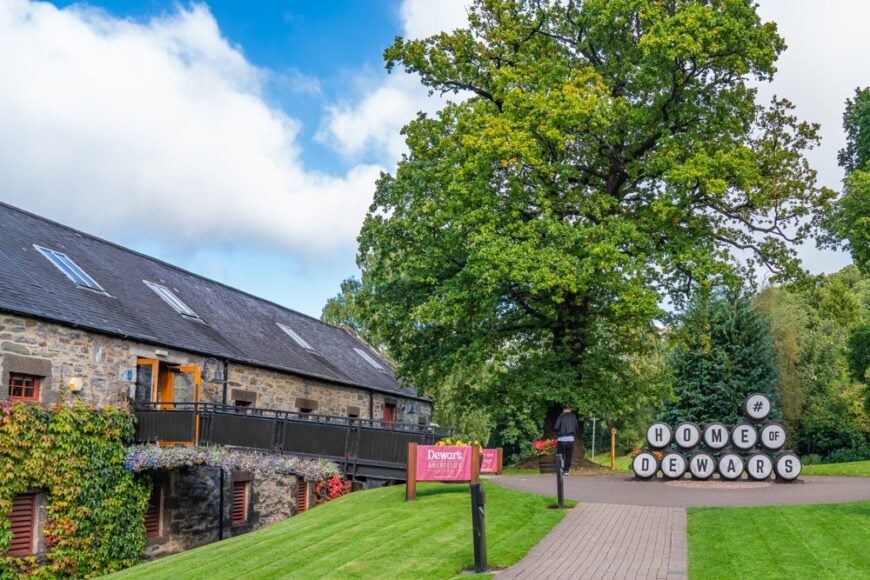Escape the hustle and bustle of modern life by venturing into the heart of Scotland’s Central Highlands, where secluded towns offer tranquil retreats amidst stunning natural beauty. These hidden gems are nestled among rolling hills, serene lochs, and ancient forests, providing the perfect backdrop for a peaceful getaway. Whether you’re an outdoor enthusiast, a history buff, or simply seeking solitude, the Highlands’ secluded towns have something special to offer. Join us as we countdown the top ten secluded towns in the Central Highlands of Scotland, each with its own unique charm and secrets waiting to be discovered.
10. Aberfeldy

Aberfeldy, a charming town with a population of just over 2,000, is perched on the banks of the River Tay. Surrounded by rolling hills and verdant landscapes, it’s a haven for nature lovers and outdoor enthusiasts. Visitors can hike the famous Birks of Aberfeldy, a picturesque woodland gorge immortalized by poet Robert Burns, or explore the historic Wade’s Bridge. The town is also home to Dewar’s Aberfeldy Distillery, where you can sample locally crafted whisky. Tourism and small-scale agriculture are the mainstays of the local economy, contributing to the town’s cozy, close-knit atmosphere. Aberfeldy’s seclusion is enhanced by its setting amidst expansive countryside, offering a serene environment removed from the hustle of city life.
Where is Aberfeldy?

Nestled in Perthshire, Aberfeldy is located approximately 30 miles northwest of Perth. Its secluded nature is accentuated by the surrounding hills and the River Tay, which cocoon the town in natural beauty. The town is accessible via the A9 and A827 roads, yet its location ensures it remains a peaceful retreat. Despite its accessibility, Aberfeldy retains an off-the-beaten-path feel, making it an ideal destination for those seeking tranquility without venturing too far off course.
9. Tomintoul

Tomintoul, with a population of around 300, is renowned as the highest village in the Highlands. Situated at an elevation of 345 meters, it offers breathtaking panoramic views of the Cairngorm Mountains. The village is a gateway to outdoor adventures like hiking, mountain biking, and in winter, skiing at the nearby Lecht Ski Centre. Tomintoul is part of the famous Whisky Trail, with its own distillery producing smooth single malts that reflect the area’s character. The main industries here are tourism and whisky production, which blend seamlessly with the village’s tranquil way of life. Tomintoul’s seclusion stems from its lofty perch amid expansive moorlands, providing an escape into the rugged beauty of the Highlands.
Where is Tomintoul?

Located on the northern edge of the Cairngorms National Park in Moray, Tomintoul lies about 14 miles northeast of Grantown-on-Spey. Its remote position is deep within the Highlands, surrounded by rolling hills and wild landscapes that enhance its sense of isolation. Access to the village is via the scenic A939 road, known for its stunning vistas and winding routes through the mountains. The journey itself is part of the allure, leading visitors to a secluded haven away from bustling tourist spots.
8. Boat of Garten

Boat of Garten, often referred to as the “Osprey Village,” is a tranquil spot with a population of around 700. Nestled along the River Spey, it’s a paradise for birdwatchers and nature enthusiasts, known for the nearby RSPB Loch Garten Nature Reserve where ospreys nest. The village offers leisurely activities like golfing at the local course, strolling along woodland trails, or riding the Strathspey Steam Railway. The main industries include tourism and small businesses catering to outdoor pursuits. Its seclusion is due to its location within the Cairngorms National Park, surrounded by ancient Caledonian pine forests that provide a peaceful, unspoiled environment.
Where is Boat of Garten?

Situated in the heart of the Scottish Highlands, Boat of Garten is approximately 6 miles northeast of Aviemore. The village’s remote feel is enhanced by the lush forests and the absence of major roads, offering a quiet retreat away from heavier tourist traffic. Access is convenient via the A95 or by rail on the heritage Strathspey Railway, which adds to the charm of visiting this secluded haven. The enveloping natural beauty and serenity make Boat of Garten a perfect escape for those seeking tranquility.
7. Carrbridge

Carrbridge is a quaint village with a population of about 700, famous for its iconic Old Packhorse Bridge—the oldest stone bridge in the Highlands, dating back to 1717. Surrounded by ancient forests, it’s an ideal spot for hiking, wildlife spotting, and exploring local crafts. The village hosts the annual World Porridge Making Championship, adding a quirky charm to its tranquil setting. Forestry and tourism are primary industries, with local artisans and small businesses contributing to the economy. Carrbridge’s seclusion arises from its enclosure within dense woodlands and its distance from major tourist hubs, offering a peaceful atmosphere steeped in tradition.
Where is Carrbridge?

Located around 10 miles north of Aviemore in the Cairngorms National Park, Carrbridge sits amidst the sprawling Caledonian pine forests. Its secluded nature is heightened by the surrounding natural landscapes and minimal through traffic. The village is accessible via the A938 and A9 roads, as well as by train on the Highland Main Line, yet retains a sense of peaceful isolation. The enveloping forests and traditional Highland scenery make Carrbridge a hidden gem worth discovering.
6. Newtonmore

Newtonmore, with a population of approximately 1,000, is a secluded town set within the Cairngorms National Park. Known for its vast open spaces and rugged landscapes, it’s a prime location for hiking, mountain biking, and fishing. The Highland Folk Museum offers a glimpse into traditional Highland life, making it a cultural hotspot within this quiet town. Local industries include tourism and agriculture, with many residents engaged in farming and small businesses. Newtonmore’s seclusion is due to its expansive surroundings and the preservation of its traditional charm, providing a genuine Highland experience away from crowded destinations.
Where is Newtonmore?

Situated about 20 miles south of Aviemore, Newtonmore is accessible via the A9 but remains off the main tourist trail. The town is enveloped by mountains and moorlands, enhancing its remote feel. Train services on the Highland Main Line connect Newtonmore to larger cities, yet its geographic location ensures it remains a tranquil retreat. The surrounding natural beauty and traditional Scottish ambiance contribute to its status as a secluded haven.
5. Killiecrankie

Killiecrankie is a small village renowned for its dramatic gorge and rich history, with a population of around 100 residents. The area is famous for the Battle of Killiecrankie in 1689, and visitors can explore the breathtaking Pass of Killiecrankie, with its dense woodlands and scenic walks. The Soldier’s Leap, a historic spot where a soldier is said to have jumped across the River Garry, is a highlight for history enthusiasts. The village’s economy revolves around tourism, with its natural beauty and historical significance drawing visitors. Killiecrankie’s seclusion is amplified by the surrounding woodlands and the lack of urban development, offering a peaceful escape into nature.
Where is Killiecrankie?

Located approximately 4 miles north of Pitlochry in Perthshire, Killiecrankie is nestled within a steep-sided gorge carved by the River Garry. Its secluded setting is enhanced by the surrounding forests and the dramatic landscape. Access is via the B8079 road, which meanders through the picturesque countryside. Despite its proximity to the A9, Killiecrankie maintains a sense of isolation, making it an ideal spot for those seeking solitude amidst natural beauty.
4. Fortingall

Fortingall is a tiny village with a population of around 200, steeped in history and surrounded by stunning landscapes. It’s home to the ancient Fortingall Yew, believed to be one of the oldest trees in Europe, estimated at over 3,000 years old. The village features traditional thatched cottages and offers a serene environment for leisurely walks and exploring historical sites. Agriculture and tourism are the main industries, with a focus on preserving the village’s rich heritage. Fortingall’s seclusion comes from its remote location and the preservation of its historical charm, providing a peaceful retreat steeped in history.
Where is Fortingall?

Nestled at the entrance to Glen Lyon in Perthshire, Fortingall is about 8 miles west of Aberfeldy. Its secluded nature is due to its position at the end of minor roads, surrounded by hills and glens that create a natural barrier from busier areas. Access is via the B846, with the journey offering scenic views of the Scottish countryside. The village’s isolation amidst rolling hills and historical sites makes it a unique destination for those seeking quiet and heritage.
3. Laggan

Laggan is a peaceful hamlet with a population of around 200, located in the heart of the Central Highlands. Surrounded by rolling hills, forests, and heather-covered moors, it’s a paradise for outdoor enthusiasts. Activities include mountain biking at the Laggan Wolftrax trail centre, walking, and wildlife watching. The local economy is based on agriculture, forestry, and tourism, with small businesses supporting these industries. Laggan’s seclusion is a result of its remote location and the expansive natural landscapes that envelop it, offering an idyllic retreat from the modern world.
Where is Laggan?

Sitting near the western edge of the Cairngorms National Park, Laggan is about 10 miles west of Newtonmore. Its secluded position is enhanced by the surrounding Grampian Mountains and the absence of major roads. Access is via the A86, which winds through the scenic Spey Valley. The hamlet’s remote setting amidst vast open spaces provides a sense of isolation and tranquility, perfect for those looking to immerse themselves in nature.
2. Dalwhinnie

Dalwhinnie, one of the highest villages in Scotland at 351 meters above sea level, has a small population of around 100 residents. It’s renowned for the Dalwhinnie Distillery, the highest distillery in the country, producing famed single malt whisky. The village is surrounded by secluded landscapes ideal for walking, fishing, and exploring the rugged beauty of the Highlands. The main industries are whisky production and tourism, contributing to its quaint yet vibrant community. Dalwhinnie’s seclusion is attributed to its high-altitude location and the expansive wilderness that surrounds it, offering a serene escape.
Where is Dalwhinnie?

Positioned in the heart of the Highlands, Dalwhinnie lies at the junction of the A9 and A889 roads, about 17 miles south of Newtonmore. Despite being adjacent to a major road, the village feels remote due to the surrounding mountains and moorlands. The Dalwhinnie railway station provides connectivity, yet the village remains a quiet retreat. Its elevation and the enveloping natural landscapes enhance its seclusion, making it a perfect spot for solitude amid the Scottish wilderness.
1. Kinloch Rannoch

Kinloch Rannoch is a tranquil village at the eastern end of Loch Rannoch, with a population of around 300. Enveloped by stunning moorlands and forests, it’s an ideal destination for those seeking a serene escape into nature. Visitors can enjoy activities like hiking the surrounding hills, exploring the nearby Rannoch Moor, or simply absorbing the breathtaking views of Loch Rannoch. The village’s economy is based on tourism, forestry, and small-scale farming. Kinloch Rannoch’s seclusion is due to its remote location amidst vast natural landscapes, providing an untouched and peaceful environment.
Where is Kinloch Rannoch?

Located in Perthshire, Kinloch Rannoch sits about 20 miles west of Pitlochry. Its secluded setting is heightened by the surrounding Schiehallion mountain and the expansive Rannoch Moor. Access is via the B846, a winding road that offers stunning scenery but few signs of civilization. The village’s isolation at the edge of one of Europe’s last wilderness areas makes it the epitome of a secluded Highland retreat, ideal for those looking to disconnect and immerse themselves in nature.






